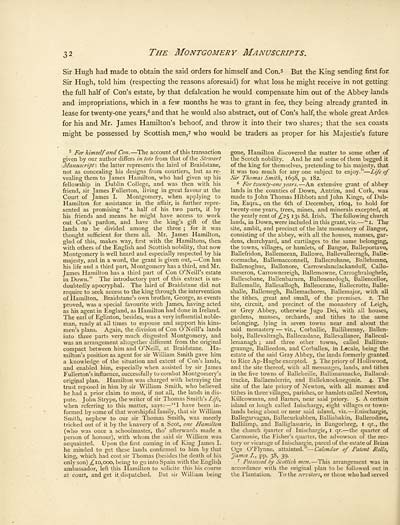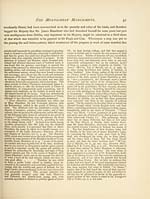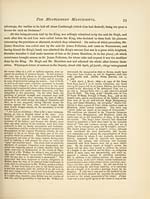Montgomery manuscripts
(46) Page 32
Download files
Complete book:
Individual page:
Thumbnail gallery: Grid view | List view

32
The Montgomery Manuscripts,
Sir Hugh had made to obtain the said orders for himself and Con.s But the King sending first for
Sir Hugh, told him (respecting the reasons aforesaid) for what loss he might receive in not getting
the full half of Con's estate, by that defalcation he would compensate him out of the Abbey lands
and impropriations, which in a few months he was to grant in fee, they being already granted in
lease for twenty-one years, 6 and that he would also abstract, out of Con's half, the whole great Ardes
for his and Mr. James Hamilton's behoof, and throw it into their two shares; that the sea coasts
might be possessed by Scottish men,? who would be traders as proper for his Majestie's future
5 For himself 'and Con.— -The account of this transaction
given by our author differs in toto from that of the Stewart
Manuscript : the latter represents the laird of Braidstane,
not as concealing his designs from courtiers, but as re-
vealing them to James Hamilton, who had given up his
fellowship in Dublin College, and was then with his
friend, sir James Fullerton, living in great favour at the
Court of James I. Montgomery, when applying to
Hamilton for assistance in the affair, is further repre-
sented as promising "a half of his two parts, if by
his friends and means he might have access to work
out Con's pardon, and have the king's gift of the
lands to be divided among the tliree ; for it was
thought sufficient for them all. Mr. James Hamilton,
glad of this, makes way, first with the Hamiltons, then
with others of the English and Scottish nobility, that now
Montgomery is well heard and especially respected by his
majesty, and in a word, the grant is given out, — Con has
his life and a third part, Montgomery has a third, and Mr.
James Hamilton has a third part of Con O'Neill's estate
in Down." The introductory part of this extract is un-
doubtedly apocryphal. The laird of Braidstane did not
require to seek access to the king through the intervention
of Hamilton. Braidstane's own brother, George, as events
proved, was a special favourite with James, having acted
as his agent in England, as Hamilton had done in Ireland.
The earl of Eglinton, besides, was a very influential noble-
man, ready at all times to espouse and support his kins-
men's plans. Again, the division of Con O'Neill's lands
into three parts very much disgusted Montgomery, and
was an arrangement altogether different from the original
compact between him and O'Neill, at Braidstane. Ha-
milton's position as agent for sir William Smith gave him
a knowledge of the situation and extent of Con's lands,
and enabled him, especially when assisted by sir James
Fullerton's influence, successfully to combat Montgomery's
original plan. Hamilton was charged with betraying the
trust reposed in him by sir William Smith, who believed
he had a prior claim to most, if not all, the lands in dis-
pute. John Strype, the writer of sir Thomas Smith's Life,
when referring to this matter, says: — "I have been in-
formed by some of that worshipful family, that sir William
Smith, nephew to our sir Thomas Smith, was meerly
tricked out of it by the knavery of a Scot, one Hamilton
(who was once a schoolmaster, tho' afterwards made a
person of honour), with whom the said sir William was
acquainted. Upon the first coming in of King James I.
he minded to get these lands confirmed to him by that
king, which had cost sir Thomas (besides the death of his
only son) ^10,000, being to go into Spain with the English
ambassador, left this Hamilton to solicite this his course
at court, and get it dispatched. But sir William being
gone, Hamilton discovered the matter to some other of
the Scotch nobility. And he and some of them begged it
of the king for themselves, pretending to his majesty, that
it was too much for any one subject to enjoy." — Life of
Sir Thomas Smith, 1698, p. 182.
6 For twenty-one years. — An extensive grant of abbey
lands in the counties of Down, Antrim, and Cork, was
made to John Thomas Hibbots and John Kinge, of Dub-
lin, Esqrs., on the 6th of December, 1604, to hold for
twenty-one years, trees, mines, and minerals excepted, at
the yearly rent of £1$ 13s 8d. Irish. The following church
lands, in Down, were included in this grant, viz. — " 1. The
site, ambit, and precinct of the late monastery of Bangor,
consisting of the abbey, with all the houses, manses, gar-
dens, churchyard, and curtilages to the same belonging,
the towns, villages, or hamlets, of Bangor, Balleportavo,
Ballefridon, Ballemeean, Ballowe, Ballevullecragh, Balle-
cormache, Ballemacconnell, Ballecrohane, Ballehunne,
Ballenoghue, Ballonore, Carrowslanclackanduff, Callo-
sneseron, Carrownereigh, Ballemowne, Carroghraloghele,
Ballesebane, Ballenbamen, Balleneardogh, Ballencellor,
Ballemulle, Ballesallogh, Balleocrane, Ballecrotte, Balle-
shalle, Ballemegh, Ballemachores, Ballemajor, with all
the tithes, great and small, of the premises. 2. The
site, circuit, and precinct of the monastery of Leigh,
or Grey Abbey, otherwise Jugo Dei, with all houses,
gardens, manses, orchards, and tithes to the same
belonging, lying in seven towns near and about the
said monastery — viz., Corballie, Ballibrenny, Ballen-
boly, Ballevaltragh, Ballecaslane, Ballevallanee, Ballecul-
lemanagh ; and three other towns, called Ballitun-
graunge, Ballieedon, and Corballen, in Lecale, being the
estate of the said Gray Abbey, the lands formerly granted
to Rice Ap-Hughe excepted. 3. The priory of Holliwood,
and the site thereof, with all messuages, lands, and tithes
in the five towns of Ballekeille, Ballimannacke, Ballacul-
tracke, Ballaenderrie, and Balleknocknegonie. 4. The
site of the late priory of Newton, with all manses and
tithes in three villages, parishes, or hamlets called Newton,
Killcowman, and Barnes, near said priory. 5' A certain
island or lough called Inischargy, eight villages or town-
lands being about or near said island, viz. — Enischargie,
Ballegarvagan, Ballecurkubben, Balliabakin, Ballerodine,
Ballilimp, and Balliglassarie, in Bangorbreg, 1 qr., the
the church quarter of Inischargie, 1 qr. — the quarter of
Carmonie, the Fisher's quarter, the advowson of the rec-
tory or vicarage of Inischargie, parcel of the estate of Brian
Oge O'Flynne, attainted." — Calendar of Patent Rolls,
James I., pp. 38, 39.
1 Possessed by Scottish men. — This arrangement was in
accordance with the original plan to be followed out in
the Plantation. To the servitors, or those who had served
The Montgomery Manuscripts,
Sir Hugh had made to obtain the said orders for himself and Con.s But the King sending first for
Sir Hugh, told him (respecting the reasons aforesaid) for what loss he might receive in not getting
the full half of Con's estate, by that defalcation he would compensate him out of the Abbey lands
and impropriations, which in a few months he was to grant in fee, they being already granted in
lease for twenty-one years, 6 and that he would also abstract, out of Con's half, the whole great Ardes
for his and Mr. James Hamilton's behoof, and throw it into their two shares; that the sea coasts
might be possessed by Scottish men,? who would be traders as proper for his Majestie's future
5 For himself 'and Con.— -The account of this transaction
given by our author differs in toto from that of the Stewart
Manuscript : the latter represents the laird of Braidstane,
not as concealing his designs from courtiers, but as re-
vealing them to James Hamilton, who had given up his
fellowship in Dublin College, and was then with his
friend, sir James Fullerton, living in great favour at the
Court of James I. Montgomery, when applying to
Hamilton for assistance in the affair, is further repre-
sented as promising "a half of his two parts, if by
his friends and means he might have access to work
out Con's pardon, and have the king's gift of the
lands to be divided among the tliree ; for it was
thought sufficient for them all. Mr. James Hamilton,
glad of this, makes way, first with the Hamiltons, then
with others of the English and Scottish nobility, that now
Montgomery is well heard and especially respected by his
majesty, and in a word, the grant is given out, — Con has
his life and a third part, Montgomery has a third, and Mr.
James Hamilton has a third part of Con O'Neill's estate
in Down." The introductory part of this extract is un-
doubtedly apocryphal. The laird of Braidstane did not
require to seek access to the king through the intervention
of Hamilton. Braidstane's own brother, George, as events
proved, was a special favourite with James, having acted
as his agent in England, as Hamilton had done in Ireland.
The earl of Eglinton, besides, was a very influential noble-
man, ready at all times to espouse and support his kins-
men's plans. Again, the division of Con O'Neill's lands
into three parts very much disgusted Montgomery, and
was an arrangement altogether different from the original
compact between him and O'Neill, at Braidstane. Ha-
milton's position as agent for sir William Smith gave him
a knowledge of the situation and extent of Con's lands,
and enabled him, especially when assisted by sir James
Fullerton's influence, successfully to combat Montgomery's
original plan. Hamilton was charged with betraying the
trust reposed in him by sir William Smith, who believed
he had a prior claim to most, if not all, the lands in dis-
pute. John Strype, the writer of sir Thomas Smith's Life,
when referring to this matter, says: — "I have been in-
formed by some of that worshipful family, that sir William
Smith, nephew to our sir Thomas Smith, was meerly
tricked out of it by the knavery of a Scot, one Hamilton
(who was once a schoolmaster, tho' afterwards made a
person of honour), with whom the said sir William was
acquainted. Upon the first coming in of King James I.
he minded to get these lands confirmed to him by that
king, which had cost sir Thomas (besides the death of his
only son) ^10,000, being to go into Spain with the English
ambassador, left this Hamilton to solicite this his course
at court, and get it dispatched. But sir William being
gone, Hamilton discovered the matter to some other of
the Scotch nobility. And he and some of them begged it
of the king for themselves, pretending to his majesty, that
it was too much for any one subject to enjoy." — Life of
Sir Thomas Smith, 1698, p. 182.
6 For twenty-one years. — An extensive grant of abbey
lands in the counties of Down, Antrim, and Cork, was
made to John Thomas Hibbots and John Kinge, of Dub-
lin, Esqrs., on the 6th of December, 1604, to hold for
twenty-one years, trees, mines, and minerals excepted, at
the yearly rent of £1$ 13s 8d. Irish. The following church
lands, in Down, were included in this grant, viz. — " 1. The
site, ambit, and precinct of the late monastery of Bangor,
consisting of the abbey, with all the houses, manses, gar-
dens, churchyard, and curtilages to the same belonging,
the towns, villages, or hamlets, of Bangor, Balleportavo,
Ballefridon, Ballemeean, Ballowe, Ballevullecragh, Balle-
cormache, Ballemacconnell, Ballecrohane, Ballehunne,
Ballenoghue, Ballonore, Carrowslanclackanduff, Callo-
sneseron, Carrownereigh, Ballemowne, Carroghraloghele,
Ballesebane, Ballenbamen, Balleneardogh, Ballencellor,
Ballemulle, Ballesallogh, Balleocrane, Ballecrotte, Balle-
shalle, Ballemegh, Ballemachores, Ballemajor, with all
the tithes, great and small, of the premises. 2. The
site, circuit, and precinct of the monastery of Leigh,
or Grey Abbey, otherwise Jugo Dei, with all houses,
gardens, manses, orchards, and tithes to the same
belonging, lying in seven towns near and about the
said monastery — viz., Corballie, Ballibrenny, Ballen-
boly, Ballevaltragh, Ballecaslane, Ballevallanee, Ballecul-
lemanagh ; and three other towns, called Ballitun-
graunge, Ballieedon, and Corballen, in Lecale, being the
estate of the said Gray Abbey, the lands formerly granted
to Rice Ap-Hughe excepted. 3. The priory of Holliwood,
and the site thereof, with all messuages, lands, and tithes
in the five towns of Ballekeille, Ballimannacke, Ballacul-
tracke, Ballaenderrie, and Balleknocknegonie. 4. The
site of the late priory of Newton, with all manses and
tithes in three villages, parishes, or hamlets called Newton,
Killcowman, and Barnes, near said priory. 5' A certain
island or lough called Inischargy, eight villages or town-
lands being about or near said island, viz. — Enischargie,
Ballegarvagan, Ballecurkubben, Balliabakin, Ballerodine,
Ballilimp, and Balliglassarie, in Bangorbreg, 1 qr., the
the church quarter of Inischargie, 1 qr. — the quarter of
Carmonie, the Fisher's quarter, the advowson of the rec-
tory or vicarage of Inischargie, parcel of the estate of Brian
Oge O'Flynne, attainted." — Calendar of Patent Rolls,
James I., pp. 38, 39.
1 Possessed by Scottish men. — This arrangement was in
accordance with the original plan to be followed out in
the Plantation. To the servitors, or those who had served
Set display mode to:
![]() Universal Viewer |
Universal Viewer | ![]() Mirador |
Large image | Transcription
Mirador |
Large image | Transcription
Images and transcriptions on this page, including medium image downloads, may be used under the Creative Commons Attribution 4.0 International Licence unless otherwise stated. ![]()
| Histories of Scottish families > Montgomery manuscripts > (46) Page 32 |
|---|
| Permanent URL | https://digital.nls.uk/95233479 |
|---|
| Description | A selection of almost 400 printed items relating to the history of Scottish families, mostly dating from the 19th and early 20th centuries. Includes memoirs, genealogies and clan histories, with a few produced by emigrant families. The earliest family history goes back to AD 916. |
|---|

